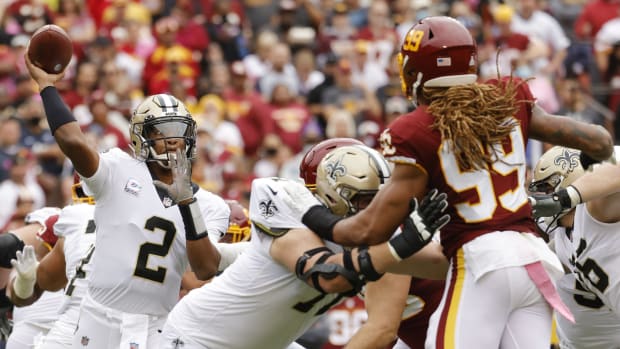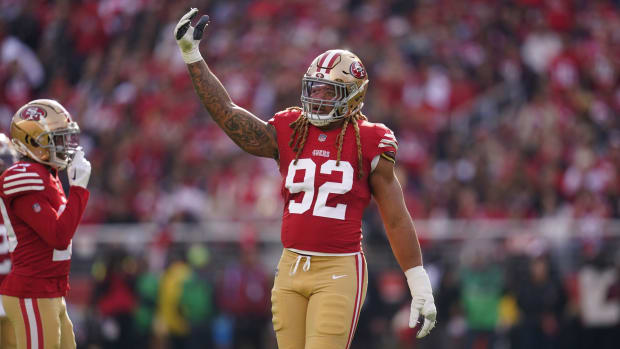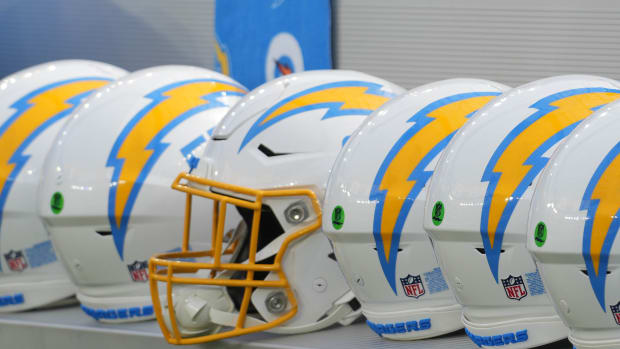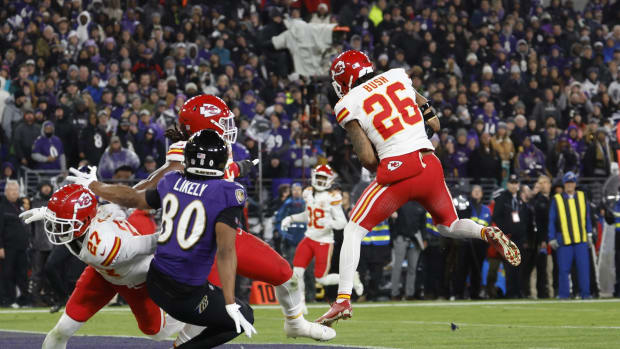
Pressure Points: An Eagle Takes Off
Most of Fletcher Cox’s first 20 games since being drafted by the Eagles in the first round two years ago have been a mixed bag, with a couple flashes here and some underwhelming play there. It didn’t help that as soon as the 6-4, 300-pound tackle finally got the hang of the Eagles’ 4-3 scheme, the coaching staff was fired. In came a new 3-4 scheme under coordinator Bill Davis, and a new two-down position as a 3-4 end.
But judging by the early results, Cox’s learning curve is getting less steep. Despite not having a sack against the Buccaneers on Sunday, Cox tied Cincinnati’s Geno Atkins for second among interior rushers with 4.0 Pressure Points to be named The MMQB’s Unsung Interior Rusher for Week 6.
Fletcher was productive because of his six quarterback hurries and two hits. It’s amazing he finished this high on the list considering top interior rusher Jason Hatcher of the Cowboys (two sacks) and Atkins (two half sacks) took down the quarterback to earn those weighted points.
“I think the early part of the season was part of me learning what to do,” Cox told The MMQB on Wednesday. “Now I know, and I’m able to turn it loose.”
Cox’s wide-ranging impact against the Bucs was fully illustrated on back-to-back plays in the second quarter. On 2nd-and-5 from the Tampa Bay 23-yard line, Cox quickly beat backup left guard Ted Larsen (two photos below) to the inside, drawing a hold that wiped out a 14-yard run (this is not counted in our pass-rushing stats).
With Tampa Bay backed up another 10 yards, Cox was then able to pin his ears back and beat right guard Davin Joseph and hit quarterback Mike Glennon as he threw, causing an interception (next two photos). Cox did this stuff all day to the Bucs.
“Fletcher had his best game of the year and we needed it and it showed,” Davis said this week. “He put a lot of pressure on the quarterback; disrupted the throwing motion of the quarterback often. A lot of those holding calls (four) were because they couldn’t block Fletch, so we benefitted from the game that he had. If we can get him to play like that every week, we’ll keep moving forward.”
Coach Chip Kelly also praised the play of Cox, who leads the Eagles with 12.0 Pressure Points and is fourth on the team in rate—when snaps are factored in among players with at least 65 rushes (9.6%-Brandon Graham; 5.9%-Connor Barwin, Trent Cole; 5.4%-Cox).
“I think Fletch really caused a lot of havoc and it was probably the best way to say it,” Kelly said. “I think he tied up a lot of blockers and really pushed the pocket really, really well from inside.”
Cox said Kelly told him that it looked like he's having fun again.
“That’s the main thing when it comes down to it,” Cox says. “I smiled at him and said I have to keep it up.”
Interior rusher of Week 6
Jason Hatcher
The 31-year-old tackle took quickly to defensive coordinator Monte Kiffin’s switch from the 3-4 to the 4-3 with 10.4 Pressure Points in the first three games of the season. But then his effectiveness waned with 1.5 and 1.3 in Weeks 4 and 5. Well, the lull ended on Sunday against Washington as Hatcher posted a season-best 4.75 Pressure Points thanks to one solo sack, one “easy” sack, a drawn hold and four hurries. For the season, Hatcher (17.75) trails only Ndamukong Suh (18.5) in total Pressure Points among interior rushers. When snaps are factored in, Hatcher’s rate is third behind Houston’s J.J. Watt and Denver’s Malik Jackson.
Week 6 interior rusher rankings
Cumulative interior rusher rankings
Edge rusher of Week 6
Justin Houston
Kansas City might as well sponsor this award, because it’s the third time in four weeks that a Chiefs player has won it, with Houston grabbing it for the second time. The Chiefs lead the league in total MMQB Pressure Points (100.25) and points per snap (35.3%). Kansas City is the only team with more than 80 pressure points. Denver is second at 79.25, but the Broncos have gotten theirs in 15 more snaps (26.5 rate, 15th overall).
Houston’s 7.13 Pressure Points against the Raiders was a league high through six weeks, coming in just 37 snaps. Cameron Wake (43 snaps in Week 1) and Mario Williams (42 snaps in Week 2) held the top spot with 6.6 Pressure Points.
Against Oakland, Houston posted one solo sack, split an “easy” sacked caused by coverage, added seven hurries and three hits. Houston also earned a sack assist on the Tamba Hali shown sack below. Houston played his role perfectly. Since the Chiefs didn’t want the elusive Terrell Pryor to get free of the pocket, Kansas City often used a “mush rush”—where a defender’s goal is to stay in his lane and not be so aggressive as to open up running lanes for the quarterback. Houston watched Pryor, and when Houston felt Pryor wouldn’t break contain, he pounced. At the end, Houston was in Pryor’s face and forced him to retreat—right into the arms of Hali, who had come the long way from the back side.
For the season, Houston leads our rankings in total pressure points and has opened a comfortable lead in pressure rate over Baltimore’s Elvis Dumervil.
Unsung edge rusher of Week 6
Junior Galette
The end didn’t have any sacks against the Patriots, but he was impactful, with three hurries, a drawn hold and two sack assists. On the first, he forced Tom Brady into Cameron Jordan to produce an “easy” coverage sack as Brady held the ball too long with 10:31 left in the first quarter. With 1:34 remaining in the second quarter, Galette’s penetration into the B gap between Patriots left guard Logan Mankins and tackle Nate Solder was so forceful that both Malcolm Jenkins and Ramon Humber were able to squeeze by for the split sack.
Week 6 edge rusher rankings
Cumulative edge rusher rankings
WEEK 6: TEAM PRESSURE POINTS
Cumulative defensive pressure points
Cumulative Pressure Points Allowed by O-Lines
Our Methodology
One of biggest indicators of success for NFL defensive coaches is the ability to affect the quarterback.
Sure, that means sacks, which are an official NFL statistic. And quarterback hits, which are also tallied in press boxes. But affecting the quarterback, making him feel pressure, has several other factors, most of which aren’t officially tallied (though NFL teams do them internally).
We at The MMQB thought long and hard about finding a better way to evaluate quarterback pressure, both from individual and team standpoints. We've developed our own formula, which we think will highlight players who aren’t getting the glory stats (sacks) but are still affecting the quarterback just as much.
The two statistics that we'll be tabulating are sack assists and drawn holds. The latter is self-explanatory. Pass rushers are sometimes held by offensive lineman before they can sack the quarterback. Those plays aren’t official plays for the NFL. But they can be nearly as damaging. It’s a 10-yard foul, although there is no loss of down.
A sack assist is given to a player who allows a teammate to get a sack. You see it all the time. One player comes flying at a quarterback, causing him to bolt, and the QB winds up in the arms of a different defender. Sometimes the sacker didn't do very much, yet he still gets credit for the sack. The player who actually caused the sack gets nothing. We’re going to change that.
Here’s how the formula works.
Sacks
Because not all sacks are created equally, we have divided up sacks into three categories: solo, assisted and easy.
Solo sack (1.25 points): For the player who beats a blocker and gets the sack on his own. These are the real sack masters; they should be rewarded for their standout individual effort.
Assisted sack (.75 points): Given to the player who officially receives a sack but had help from a teammate in taking the quarterback down.
Easy sack (.75 points): An official sack that falls into one of the following categories: coverage sack (quarterback held the ball longer than 3.3 seconds because the coverage was so good); unblocked, usually because of a schemed blitz; offensive miscue, such as the quarterback tripping after getting stepped on by an offensive lineman; or garbage-time sack, which we have defined as a sack when the offense is trailing by more than two scores with four minutes or less remaining in the game.
Sack assist (.5 points): As described above, this is when a player aids in the sacking of a quarterback. The official sacker will get an “assisted” or “easy” sack (.75 points), and the disrupter gets a “sack assist.”
Disruptions
These three categories—drawn holds, hurries and hits—are not official statistics, but they’re extremely important. A team can have zero sacks, but if they accumulate hurries or hits, they’re making life extremely uncomfortable for a quarterback. The hurries and hits are shared with us by our friends at ProFootballFocus.com. Our hits and hurries include plays wiped out by penalty.
Drawn hold (.75 points): The player who draws a holding penalty on a pass play. Only tabulated if the penalty results in a “no play.” If there is holding on a sack and the sack counts, there is no drawn hold—although that player could get a sack assist.
Hurry (.5 points): When the actions of a defender causes the quarterback to alter his throw or footwork. This is what defenses call “moving a quarterback off his spot.”
Hit (.5 points): Recorded just after or as the quarterback releases a pass and goes to the ground as a result of contact with a defender.
Pressure Points
edge rushers
interior rushers
by team


















































